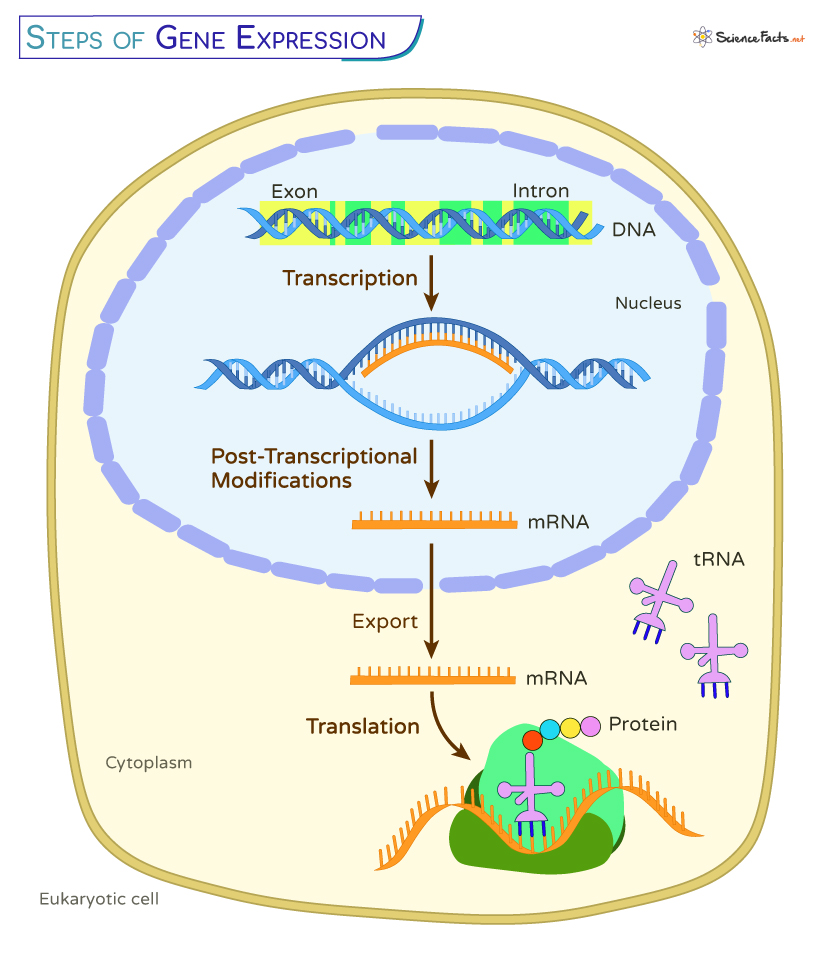Gene Expression
Gene expression is a series of steps by which information encoded in genes creates functional products, such as RNA or proteins. It is a fundamental process that plays a crucial role in all living organisms’ development, functioning, and regulation.
Gene expression is the cell’s way of managing the amount and timing of the products created by our genes. This control is crucial because it allows cells to produce the necessary gene products exactly when needed, allowing cells to adapt to a changing environment, respond to signals, and handle damage and other triggers.
An example is the control of insulin gene expression that provides regulation of blood glucose.
How Genes are Expressed
The process of gene expression involves the following steps: transcription, post-transcriptional modification, and translation.
1. Transcription
It is the first step of gene expression in which the genetic information encoded in DNA is transcribed into RNA. RNA polymerase reads the DNA template during transcription and synthesizes a complementary RNA strand.
In prokaryotes, transcription occurs in the cytosol, while eukaryotic transcription occurs in the nucleus, where DNA is stored. In eukaryotes, the resulting RNA molecule, the RNA transcript, carries the information from the nucleus to the cytoplasm.
Transcription involves several key stages:
- Initiation: It starts when RNA polymerase binds to the promoter region near the gene, unwinding a segment of the DNA to expose the gene’s coding region.
- Elongation: The polymerase then moves along the DNA template strand, adding RNA nucleotides complementary to the DNA sequence, thus synthesizing the mRNA strand.
- Termination: Finally, the enzyme encounters a termination signal, after which it dissociates and releases the newly synthesized mRNA molecule.
2. Post-transcriptional Modification (mRNA Processing)
In prokaryotes, the transcript (messenger RNA) directly acts as the template for the ribosome to carry out protein synthesis (translation). However, before leaving the nucleus, the newly formed mRNA undergoes RNA processing in eukaryotes. It involves three steps:
- 5′ Capping: Adding a 5′ cap to the mRNA aids in mRNA stability and initiation of translation.
- Polyadenylation: Adding a poly-A tail at the 3′ end contributes to mRNA stability and export from the nucleus.
- Splicing: Removing non-coding sequences (introns) from the mRNA, leaving only the coding sequences (exons).
The final product, now mature mRNA, is ready for translation in the cytoplasm.
3. Translation
In the cytoplasm, the mature mRNA serves as a template for translation, the process by which proteins (the final product of gene expression) are synthesized. Ribosomes, the cellular machinery accountable for protein synthesis, read the mRNA codons (three-base sequences) and match them with transfer RNA (tRNA) molecules carrying specific amino acids. 61 codons specify amino acids, where one is the start codon, the site of initiation, and three stop codons signal the end of the polypeptide synthesis.
As the ribosome moves along the mRNA, amino acids are joined together, forming a polypeptide chain, eventually folding into a functional protein.
In prokaryotes, like transcription, translation also occurs in the cytoplasm.
Translation involves several key stages:
- Initiation: The ribosome assembles around the target mRNA. The first tRNA attached to the appropriate amino acids is brought to the initiation site.
- Elongation: tRNAs with the appropriate amino acid then bind to the ribosome, which is then added to the growing polypeptide chain depending on the sequence of codons in the mRNA.
- Termination: Finally, when a stop codon is reached, the ribosome releases the polypeptide, which may undergo further folding and modification to become a functional protein.
Regulation of Gene Expression
Gene expression is a highly orchestrated process that causes cells to adapt to changing environments and developmental needs. Regulatory proteins and small RNA molecules control when and how genes are transcribed and translated.
Regulations are made at the level of transcription, post-transcription, translation, and post-translation stages involving the following regulators and processes:
Transcriptional Regulation
- Promoter and Enhancer Elements: These specific DNA sequences can enhance or inhibit transcription by binding transcription factors.
- Transcription Factors: It involves proteins that bind to DNA sequences, influencing the rate of transcription initiation by RNA polymerase.
- DNA and histone modifications: Evidence suggests that DNA methylation increases gene expression in dividing cells.
Post-transcriptional Regulation
- Alternative Splicing: Producing different mRNA molecules from the same pre-mRNA, resulting in different proteins.
- mRNA Stability: The lifespan of mRNA molecules can be regulated, affecting the amount of protein produced.
Translational Regulation
- mRNA Surveillance: Mechanisms like nonsense-mediated decay (NMD) eliminate mRNAs that contain errors, preventing the production of abnormal proteins.
- Regulation of Translation Initiation: Factors that influence the initiation phase can affect the overall rate of protein synthesis.
Post-translational Modification
- Protein Folding, Modification, and Degradation: Proteins can be modified after translation, affecting their activity, localization, and stability.
-
References
Article was last reviewed on Saturday, March 30, 2024




